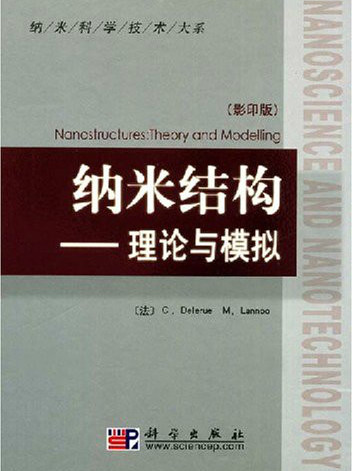《納米結構——理論與模擬》是2008年科學出版社出版的圖書。
基本介紹
- 書名:納米結構——理論與模擬
- 定價:78.00
- 出版社:科學出版社
- 出版時間:2008年6月出版
基本信息
[法] C.Delerue,[法] M.Lannoo 著 | |
2008年6月出版 | |
定價:78.00 | 語種:英文 |
標準書號:978-7-03-022027-1 | 裝幀:精裝 |
版本:第一版 影印版 | 開本:B5 |
責任編輯:袁琦 | 字數:396千字 |
讀者對象:本科以上文化程度 | 頁數:304 |
書類:理論專著/研究生教育 | 冊/包:6 |
編輯部: 科學化學化工分社 | |
內容簡介
該書對從事納米科技多學科交叉領域的高年級本科生、研究生及相關的科研教學人員具有重要的參考價值。
圖書目錄
1.1 Ab initio One-Particle Theories for the Ground State
1.1.1 Non-interacting N Electron System
1.1.2 The Hartree Approximation
1.1.3 The Hartree-Fock Approximation
1.1.4 Correlations and Exchange-Correlation Hole
1.1.5 Local Density Approaches
1.2 Quasi-particles and Excitons
1.2.1 One-Particle Eigenvalues
1.2.2 The Exchange-Correlation Hole and Static Screening
1.2.3 Dynamically Screened Interactions
1.2.4 The GW Approximation
1.2.5 Excitons
1.2.6 Towards a More Quantitative Theory
1.2.7 Time-Dependent Density Functional Theory (TDDFT)
1.3 Semi-empirical Methods
1.3.1 The Empirical Tight Binding Method
1.3.2 The Empirical Pseudopotential Method
1.3.3 The k.p Description and Effective Masses
2 Quantum Confined Systems
2.1 Quantum Confinement and Its Consequences
2.1.1 Idealized Quantum Wells
2.1.2 Idealized Quantum Wires
2.1.3 Idealized Cubic Quantum Dots
2.1.4 Artificial Atoms: Case of Spherical Wells
2.1.5 Electronic Structure from Bulk to Quantum Dots
2.2 Computational Techniques
2.2.1 k.p Method and Envelope Function Approximation
2.2.2 Tight Binding and Empirical Pseudopotential Methods
2.2.3 Density Functional Theory
2.3 Comparison Between Different Methods
2.4 Energy Gap of Semiconductor Nanocrystals
2.5 Confined States in Semiconductor Nanocrystals
2.5.1 Electron States in Direct Gap Semiconductors
2.5.2 Electron States in Indirect Gap Semiconductors
2.5.3 Hole States
2.6 Confinement in Disordered and Amorphous Systems
3 Dielectric Properties
3.1 Macroscopic Approach: The Classical Electrostatic Theory
3.1.1 Bases of the Macroscopic Electrostatic Theory of Dielectrics
3.1.2 Coulomb Interactions in a Dielectric Quantum Well
3.1.3 Coulomb Interactions in Dielectric Quantum Dots
3.2 Quantum Mechanics of Carriers in Dielectrics:Simplified Treatments
3.2.1 Dielectric Effects in Single-Particle Problems
3.2.2 Dielectric Effects in Many-Particle Problems
3.3 Microscopic Calculations of Screening Properties
3.3.1 General Formulation in Linear-Response Theory
3.3.2 Random-Phase Approximation
3.3.3 Beyond the Random-Phase Approximation
3.3.4 From Microscopic to Macroscopic Dielectric Function for the Bulk Crystal
3.4 Concept of Dielectric Constant for Nanostructures
3.4.1 The Importance of Surface Polarization Charges
3.4.2 Dielectric Screening in Quantum Wells
3.4.3 Dielectric Screening in Quantum Dots
3.4.4 General Arguments on the Dielectric Response in Nanostructures
3.4.5 Conclusions
3.5 Charging of a Nanostructure
3.5.1 Case of a Quantum Dot
3.5.2 Case of a Quantum Well
4 Quasi-particles and Excitons
4.1 Basic Considerations
4.2 Excitons in the Envelope Function Approximation
4.2.1 Theory of Bulk Excitons
4.2.2 Excitons in Quantum Wells
4.2.3 Exciton Binding Energy in Limiting Situations
4.2.4 The Influence of Dielectric Mismatch
4.3 Excitons in More Refined Semi-empirical Approaches
4.3.1 General Discussion
4.3.2 Excitons in Nanocrystals of Direct Gap Semiconductors
4.3.3 Excitons in Si Nanocrystals
4.3.4 Screening of the Electron-Hole Interaction and Configuration Interaction
4.4 Quantitative Treatment of Quasi-particles
4.4.1 General Arguments
4.4.2 Tight Binding GW Calculations
4.4.3 Conclusions
4.5 Quantitative Treatment of Excitons
4.5.1 Numerical Calculations
4.5.2 Interpretation of the Results
4.5.3 Comparison with Experiments
4.6 Charging Effects and Multi-excitons
4.6.1 Charging Effects: Single Particle Tunneling Through Semiconductor Quantum Dots
4.6.2 Multi-excitons
4.7 Conclusion
5 Optical Properties and Radiative Processes
5.1 General Formulation
5.1.1 Optical Absorption and Stimulated Emission
5.1.2 Luminescence
5.1.3 Nanostructures in Optical Cavities and Photonic Crystals
5.1.4 Calculation of the Optical Matrix Elements
5.2 Electron-Phonon Coupling and Optical Line-Shape
5.2.1 Normal Coordinates
5.2.2 Calculation of Phonons in Nanostructures
5.2.3 Configuration Coordinate Diagram
5.2.4 General Expression for the Optical Transition Probabilities
5.2.5 Calculation of the Coupling Parameters
5.2.6 FrShlich Coupling: Optical Modes
5.2.7 Coupling to Acoustic Modes
5.2.8 The Importance of Non-adiabatic Transitions
5.3 Optical Properties of Heterostructures and Nanostructures of Direct Gap Semiconductors
5.3.1 Interband Transitions
5.3.2 Intraband Transitions
5.3.3 The Importance of Electron-Phonon Coupling
5.4 Optical Properties of Si and Ge Nanocrystals
5.4.1 Interband Transitions
5.4.2 Intraband Transitions
6 Defects and Impurities
6.1 Hydrogenic Donors
6.1.1 Envelope Function Approximation
6.1.2 Tight Binding Self-Consistent Treatment
6.2 Deep Level Defects in Nanostructures
6.3 Surface Defects: Si Dangling Bonds
6.3.1 Review of the Properties of Si Dangling Bonds
6.3.2 Si Dangling Bonds at the Surface of Crystallites
6.3.3 Dangling Bond Defects in III-V and II-VI Semiconductor Nanocrystals
6.4 Surface Defects: Self-Trapped Excitons
6.5 Oxygen Related Defects at Si-SiO2 Interfaces
7 Non-radiative and Relaxation Processes
7.1 Multi-phonon Capture at Point Defects
7.2 Auger Recombination
7.2.1 Theoretical Calculation
7.2.2 Experimental Evidence for Auger Recombination
7.3 Hot Carrier Relaxation: Existence of a Phonon Bottleneck
8 Transport
8.1 Description of the Systems and of the Boundary Conditions
8.2 Weak Coupling Limit
8.2.1 Perturbation Theory
8.2.2 Orthodox Theory of Tunneling
8.3 Beyond Perturbation Theory
8.3.1 Elastic Scattering Formalism
8.3.2 Calculation of the Green's Functions
8.4 Electron-Electron Interactions Beyond the Orthodox Theory.
8.4.1 Self-Consistent Mean-Field Calculations
8.4.2 The Self-Consistent Potential Profile
8.4.3 The Coulomb Blockade Effect
8.5 Transport in Networks of Nanostructures
8.5.1 Tunneling Between Nanostructures
8.5.2 Hopping Conductivity
8.5.3 Coherent Potential Approximation
8.5.4 Example of a Network of Silicon Nanocrystals
A Matrix Elements of the Renormalizing Potential
B Macroscopic Averages in Maxwell’s Equations
C Polarization Correction
References
Index

